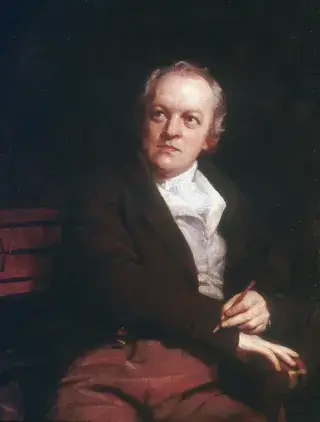Biography of William Blake

| date | place | |
|---|---|---|
| born | November 28, 1757 | Soho, London |
| died | August 12, 1827 | London |
William Blake was an English poet, painter, and printmaker, largely unrecognized during his lifetime but now considered a seminal figure in the history of both the poetry and visual arts of the Romantic Age. Born in London, Blake was the third of seven children, two of whom died in infancy. Showing early artistic promise, he was apprenticed to engraver James Basire at the age of fourteen and later enrolled at the Royal Academy of Arts. He rebelled against the prevailing academic trends of the time, favoring instead a style that drew from the imagination rather than from nature, which he believed stifled creativity. Blake married Catherine Boucher in 1782, who was crucial in his life and work, assisting him in printing his illuminated works. He developed his own method for printing both text and images, which he called "illuminated printing," and this innovation allowed him to integrate his poems with his artwork in books such as "Songs of Innocence" (1789) and "Songs of Experience" (1794), showcasing his philosophical and mystical beliefs. Despite his profound influence on Romantic and later poets and artists, Blake's work was largely ignored by the public and critics during his lifetime. He lived in relative poverty and obscurity, with his genius only being fully recognized posthumously. His visual artistry is equally celebrated, particularly his illustrations for the Book of Job and Dante's "Divine Comedy," which are considered masterpieces of British art. Blake's themes include the tyranny of oppression, the purity of childhood, the power of the imagination, and a vivid spiritual vision that was often at odds with the materialism of his age. He was deeply critical of the Church and state, yet profoundly spiritual, creating a rich mythological universe populated by his own pantheon of beings. His work expresses a fervent belief in the importance of personal freedom and imagination against the backdrop of social and political injustice. Throughout his life, Blake struggled for recognition, with his work gaining only a small following before his death. It wasn't until the late 19th century that his genius began to be fully appreciated, influencing countless artists, writers, and musicians, and securing his place as a foundational figure in the history of both literature and art. Today, William Blake is celebrated for his visionary creativity, his radical approach to both poetry and printmaking, and his profound impact on the Romantic movement and beyond. William Blake's poems are a cornerstone of English literature, embodying the spirit of the Romantic era with their profound emotional depth and revolutionary themes. As a poet, Blake was ahead of his time, crafting works that seamlessly blended profound philosophical concepts with simple, yet powerful language. His poetry collections, notably "Songs of Innocence" and "Songs of Experience," offer a stark exploration of the dichotomies of human existence, juxtaposing innocence with corruption, and freedom with repression. These works not only showcase Blake's mastery over words but also his innovative use of illuminated printing, which combined text and imagery to enhance the reader's experience. Today, William Blake Poems are studied and celebrated for their lyrical beauty, existential questioning, and bold critique of societal norms. Delving into William Blake Poems reveals a rich tapestry of mystical visions and social commentary, wrapped in a unique blend of simplicity and complexity that appeals to a wide audience. Blake's ability to convey deep spiritual and moral messages through accessible verses has cemented his status as a pivotal figure in poetry.
Feel free to be first to leave comment.